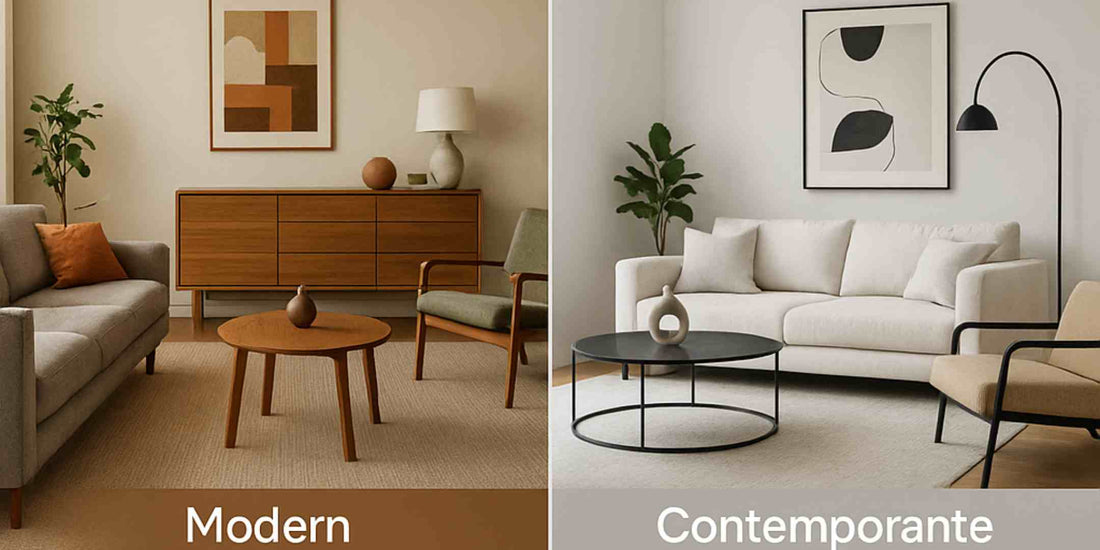
Modern vs. Contemporary: What's the Difference in Interior Design?
Share
You've probably heard it before:
"This home has such a modern vibe!"
"I love your contemporary living room!"
However, here's the thing. Modern and contemporary interior design styles are not the same thing. In fact, the two styles are rooted in very different design philosophies.
Have you ever scratched your head trying to figure out if modern and contemporary are the same thing? Or, what does "contemporary" mean in interior design? You're not alone. Even seasoned designers sometimes see these terms used interchangeably in conversation. But when it comes to creating a cohesive space, knowing the difference makes all the difference.
So, let's clear the air.
In this guide, we'll unpack the nuances of modern, contemporary, and even traditional interior design so you can better define, mix, or confidently commit to your style of choice.
Modern vs. Contemporary: Are They the Same Thing?

Let's tackle the first and most common misconception head-on: Is modern and contemporary the same thing?
No. Absolutely not.
While the words sound similar, they speak two distinct design languages.
Here's a quick cheat sheet:
| Modern | Contemporary |
| Rooted in a historical design movement (early to mid-20th century) | Reflects current design trends and aesthetics. |
| Focus on function and simplicity. |
Evolving and fluid—changes with the times |
| Clean lines, natural materials |
Bold contrasts, mixed materials, statement pieces |
| It has an earthy, neutral palette. |
Neutral base with pops of color or trend-driven accents |
So, if you walk into a space that feels crisp and sleek with timeless mid-century furniture, it's probably modern.
If it looks current and edgy, maybe with curved sofas and sculptural lighting? That's likely contemporary.
What Does "Contemporary" Mean in Interior Design?
Here's where it gets even more fun. What does "contemporary" mean in interior design?
In one word: now.
Contemporary interior design is about what's trending right now—what designers and homeowners are leaning into at this moment. The catch? That "moment" evolves constantly.
Contemporary Interior Design Characteristics:
- Open and uncluttered spaces
- Neutral base palette (white, taupe, gray) layered with bold accent pieces
- Curves and organic shapes (think rounded sofas, soft edges)
- Statement lighting (sculptural pendants, oversized floor lamps)
- A mix of materials—glass, metal, stone, wood
- Texture play (layering smooth and rough textures for depth)
- Sustainable and innovative materials—eco-conscious design is big in today's contemporary spaces
Fun fact: a contemporary interior design style from 2010 (all sleek minimalism and stainless steel) looks quite different from today's version, which leans softer, more organic, and layered.
Pro tip: Contemporary is an excellent choice for those who like to stay current and refresh their interiors every few years.
What Is Modern Interior Design?
Now, let's rewind a bit.
Modern interior design has its roots in the early to mid-20th century, heavily influenced by movements like Bauhaus and Scandinavian design.
At its core, modern design was a response to the ornate and overly decorative styles that preceded it. The philosophy? Form follows function.
Key Characteristics of Modern Design:
- Clean, straight lines—geometry reigns
- Open floor plans—maximize space and flow
- Natural materials—wood, leather, linen, stone
- Minimal ornamentation—everything serves a purpose
- Neutral and earthy palette—whites, beiges, browns, muted greens
- Unadorned windows—let in as much natural light as possible
You'll often see modern homes featuring mid-century modern furniture, such as Eames chairs, teak credenzas, or Noguchi tables.
Modern interior design is timeless. It doesn't chase trends, making it an ideal choice for homeowners seeking a calm, grounded, and uncluttered space.
What Is the Difference Between Modern, Traditional, and Contemporary?
Here's another common question: What is the difference between modern, traditional, and contemporary?
| Traditional | Modern |
Contemporary |
| Rooted in history—often inspired by 18th and 19th-century design | Rooted in early 20th-century design |
It reflects current design trends |
| Ornate, detailed moldings | Clean lines, minimal details |
Bold contrasts, organic shapes |
| Rich, layered color palettes | Neutral, earthy tones |
Neutral base with trend-driven accents |
| Classic furniture, antique pieces | Mid-century modern furniture |
A mix of vintage and new sculptural forms |
Traditional spaces might feature heavy drapes, crystal chandeliers, ornate furniture, and layered textures.
Modern spaces feel more open, spare, and functional.
Contemporary interiors walk the line—bold, current, and ever-evolving.
Contemporary Interior Design Characteristics (In Detail)
Let's take a deeper dive into contemporary interior design characteristics, as this style is in high demand right now, particularly among homeowners and designers in urban areas.
1. Airy, Open Spaces
Contemporary homes emphasize openness. You won't find heavy furniture or overstuffed rooms here. Spaces are intentionally curated and breathable.
2. Curves & Organic Forms
One of the most defining trends today is the use of curves. From arched doorways to rounded sofas and soft-edged coffee tables, contemporary design embodies a sense of flow and softness.
3. Bold Contrast
While the base palette is often neutral, pops of black, cobalt blue, terracotta, or emerald green are common. These accents add drama and a modern touch to the space.
4. Texture Layering
Think boucle chairs paired with matte black metal frames. Concrete walls softened with woven throws and plush rugs. Texture brings warmth to an otherwise minimalist aesthetic.
5. Art as a Focal Point
Statement artwork is a significant feature in contemporary interior design style—whether in the Form of oversized abstracts, gallery walls, or sculptural pieces.
Should You Choose Modern or Contemporary?
Here's where it gets personal.
If you want:
- A space that will look stylish 10 20 years from now: go modern.
- A space that feels fresh, current, and experimental: choose contemporary.
Blending both styles? Yes, it's possible and very chic when done well.
Here's how an experienced interior designer might do it:
- Begin with a modern base, characterized by clean lines and high-quality materials.
- Layer in contemporary pieces—a curved sofa, statement lighting, and bold art.
Caution: Be intentional. Too much blending without a plan can feel disjointed.
Real-Life Design Tips
Here's a bit of insider advice:
1. Shopping for Furniture? Read Between the Lines.
If a listing describes a space as "modern," but the sofa appears to be from 2023 trend boards, it's likely contemporary. Many retailers blur the terms.
2. Communicating with Contractors
Be specific! If you tell your contractor you want a modern interior design, specify:
- Materials you expect (wood, natural stone, etc.)
- Minimal detailing
- Clean, architectural lines
For contemporary highlight:
- Curves you want to be incorporated.
- Mix of materials
- Current design references
3. Mistakes to Avoid
- Don't confuse trendy with timeless. Contemporary design can date quickly. Choose trend-driven pieces you're comfortable replacing in 5–7 years.
- Don't force modern elements into an ornate, traditional home without considering the architectural envelope.
Final Thoughts
So, what's the final takeaway between modern and contemporary interior design styles?
- Modern = historical movement, timeless, grounded.
- Contemporary = current, dynamic, evolving.
And no! Modern and contemporary are not the same thing.
What does "contemporary" mean in interior design? It represents the moment. It means embracing change, technology, and new forms of expression.
What is the difference between modern, traditional, and contemporary? It comes down to:
- Origin
- Materials
- Color palettes
- Overall vibe
Contemporary interior design characteristics reflect today's trends—but you can (and should) make them your own.
Final advice: Don't feel pressured to pick one style. The best homes layer personal taste with a design backbone that fits your lifestyle.
So whether you lean modern, contemporary, or a delicious blend of both, design with intention, and your space will always feel like home.
